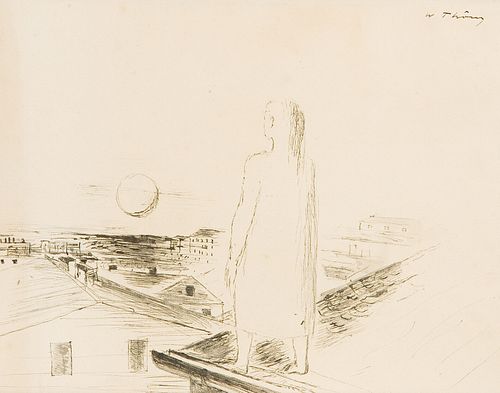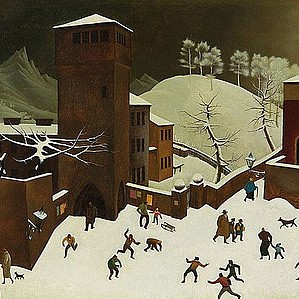WILHELM THÖNY (Graz 1888 - 1949 New York) On the Roof, around 1937
Lot 90
Categories
Estimate:
EUR€2,000 - EUR€3,000
$2,150.54 - $3,225.81
Absentee vs Live bid
Two ways to bid:
- Leave a max absentee bid and the platform will bid on your behalf up to your maximum bid during the live auction.
- Bid live during the auction and your bids will be submitted real-time to the auctioneer.
Bid Increments
| Price | Bid Increment |
|---|---|
| EUR€0 | EUR€10 |
| EUR€100 | EUR€50 |
| EUR€700 | EUR€100 |
| EUR€1,000 | EUR€200 |
| EUR€3,000 | EUR€300 |
| EUR€3,600 | EUR€400 |
| EUR€4,000 | EUR€500 |
| EUR€7,000 | EUR€1,000 |
| EUR€16,000 | EUR€2,000 |
| EUR€30,000 | EUR€3,000 |
| EUR€36,000 | EUR€4,000 |
| EUR€40,000 | EUR€5,000 |
About Auction
By Widder Auctions
May 19, 2022
Set Reminder
2022-05-19 11:00:00
2022-05-19 11:00:00
America/New_York
Bidsquare
Bidsquare : Masterpieces
https://www.bidsquare.com/auctions/widder-auctions/masterpieces-9287
Masterpieces of classical modernism by Austrian and international artists coming up for auction in Vienna on May 19th Widder Auctions office@widderauktionen.com
Masterpieces of classical modernism by Austrian and international artists coming up for auction in Vienna on May 19th Widder Auctions office@widderauktionen.com
- Lot Description
WILHELM THÖNY
(Graz 1888 - 1949 New York)
On the Roof, around 1937
indian ink, washed/paper, 22,5 x 29 cm
signed W Thöny
Provenance: private property Vienna
ESTIMATE °€ 2.000 - 3.000
Austrian painter, graphic artist, etcher and illustrator of the 20th century, important representative of Austrian modernism. 1908 to 1912 studied at the Academy of Fine Arts with Angelo Jank and Gabriel von Hackl. Also training in singing and playing the piano. Co-founder of the Munich Secession, lifelong acquaintance with Alfred Kubin. As a one-year volunteer in World War I, he created portrait studies and illustrations as a regimental painter. 1923 co-founder of the Graz Secession. 1925 Marries Thea Herrmann-Trautner, daughter of the American painter Frank S. Herrmann, sister of the painter and caricaturist Eva Herrmann. 1929 first stay in Paris, lived in Paris from 1931 to 1938. 1938 Emigrated to New York with his Jewish wife. 1948 Destruction of most of his works in a fire in a warehouse in New York. Diverse themes and techniques, landscapes and above all cityscapes of large cities such as Paris and New York. The genre scenes also show engagement with Advard Munch and August Macke.
Thöny pursues something profound in the ink drawing with the figure on the roof of a house, which is balancing here in the middle of a settlement that is only hinted at in a nightgown with a view into the distance. In the background, the moon rises above the middle ground, which Thöny sketches vaguely as a seascape. One could see a sleepwalker in the woman. Many myths and theories have formed around somnambulism throughout history. This is what the father of psychoanalysis, Sigmund Freud, said in 1915: he linked somnambulism to the fulfillment of repressed sexual desires and at the same time proposed the theory that sleepwalkers want to return to where they slept as children. Equally likely, however, is the interpretation that the person looking longingly into the distance is a person desperately seeking exile, who now sees no way out on the edge of the roof and, as a farewell, one last look at the port of Sanary-sur-Mer as the final destination of their emigration. In the 1930s, the city on the French Mediterranean coast was a meeting place for numerous European intellectuals and artists, and Thöny also depicted it in several of his paintings. In the drawing, the sun sets in front of the suicidal woman. Thöny managed to escape. In 1938 he finally emigrated to New York with his Jewish wife Thea.
PLEASE NOTE:
The purchase price consists of the highest bid plus the buyer's premium, sales tax and, if applicable, the fee of artists resale rights. In the case of normal taxation (marked ° in the catalog), a premium of 24% is added to the highest bid. The mandatory sales tax of 13% is added to the sum of the highest bid and the buyer's premium. The buyer's premium amounts to 28% in case of differential taxation. The sales tax is included in the differential taxation. - Shipping Info
-
Shipping
We will send you the invoice shortly after the auction. As soon as we have recieved the amount, the art can be picked up at Johannesgasse 9-13, 1010 Vienna. Please note that the buyer is responsible for pick-up and shipping of the lot.
Should you wish to ship your items, please contact: Mailboxes Email: oper@mbe-co.at Tel: 01 5128855
Please note that storage fees may apply, should the pieces not be picked up within 14 days after invoicing for domestic and 28 days for international transportation.
Our team will be happy to assist you with any further information at office@widderauktionen.com or at 0043 676 555 66 10.
-
- Buyer's Premium



 EUR
EUR CAD
CAD AUD
AUD GBP
GBP MXN
MXN HKD
HKD CNY
CNY MYR
MYR SEK
SEK SGD
SGD CHF
CHF THB
THB













